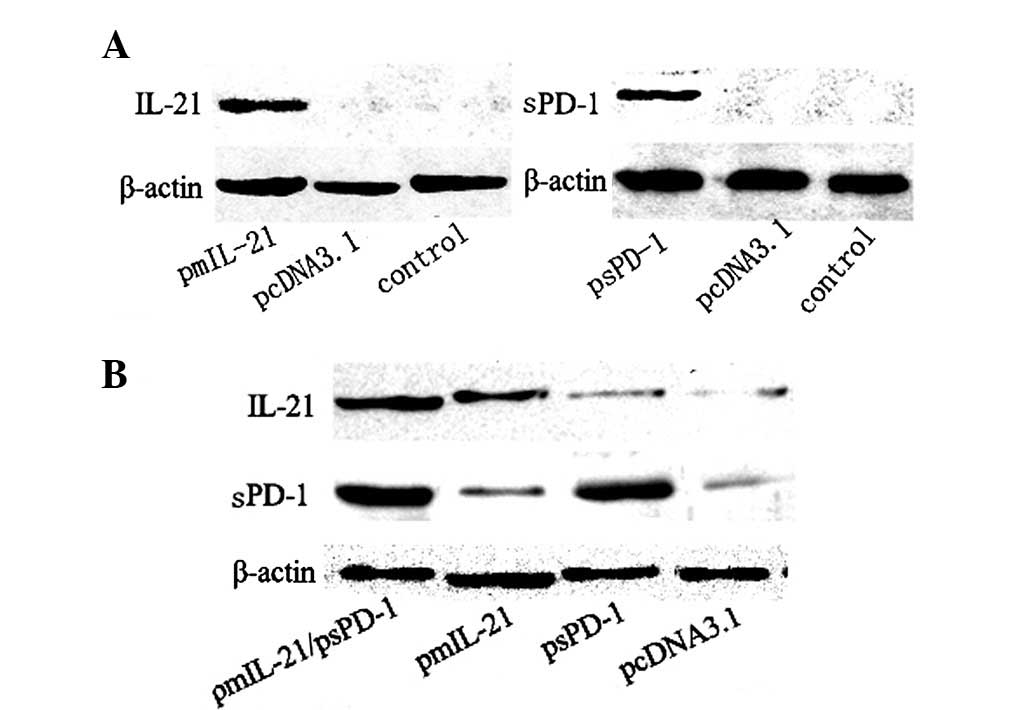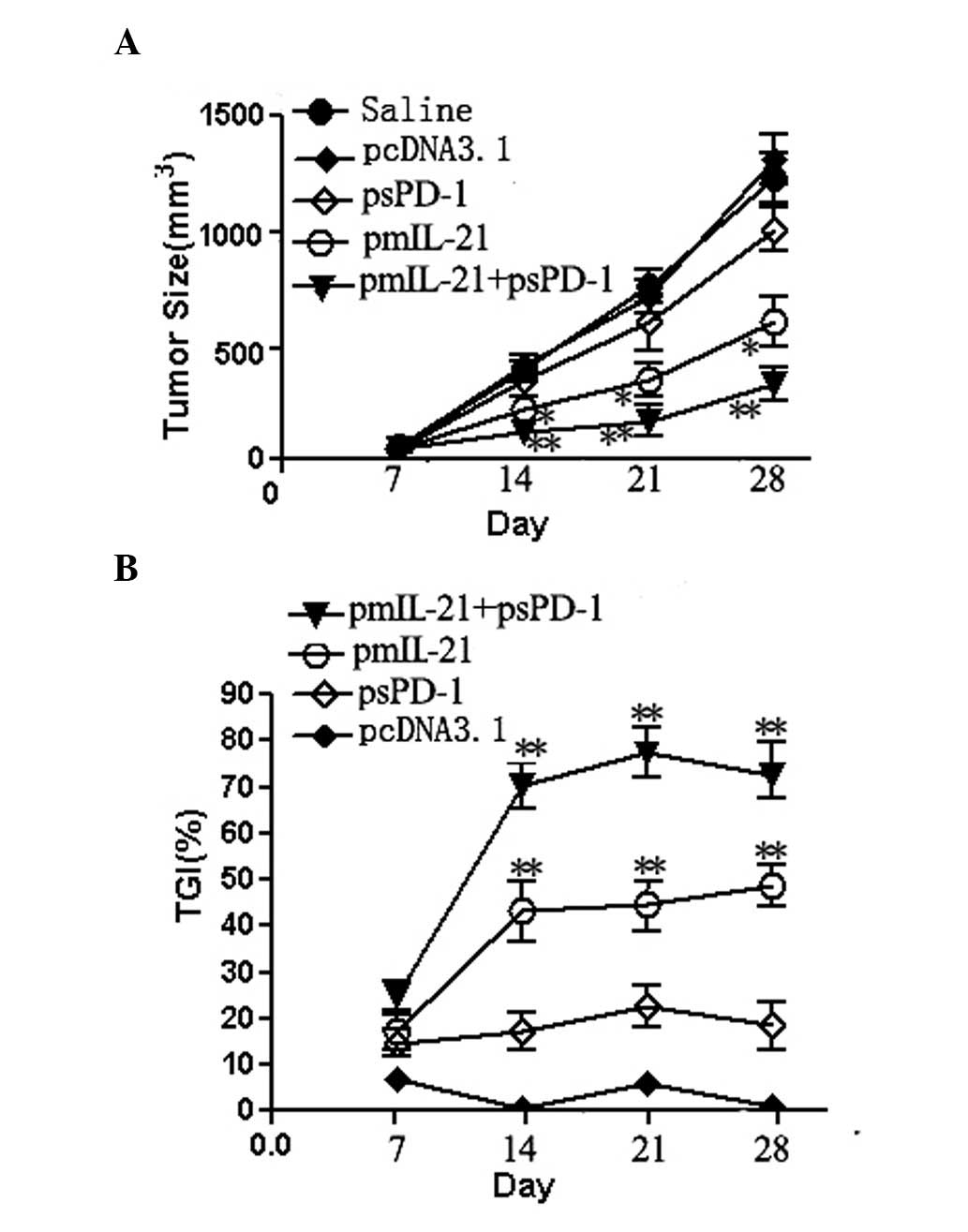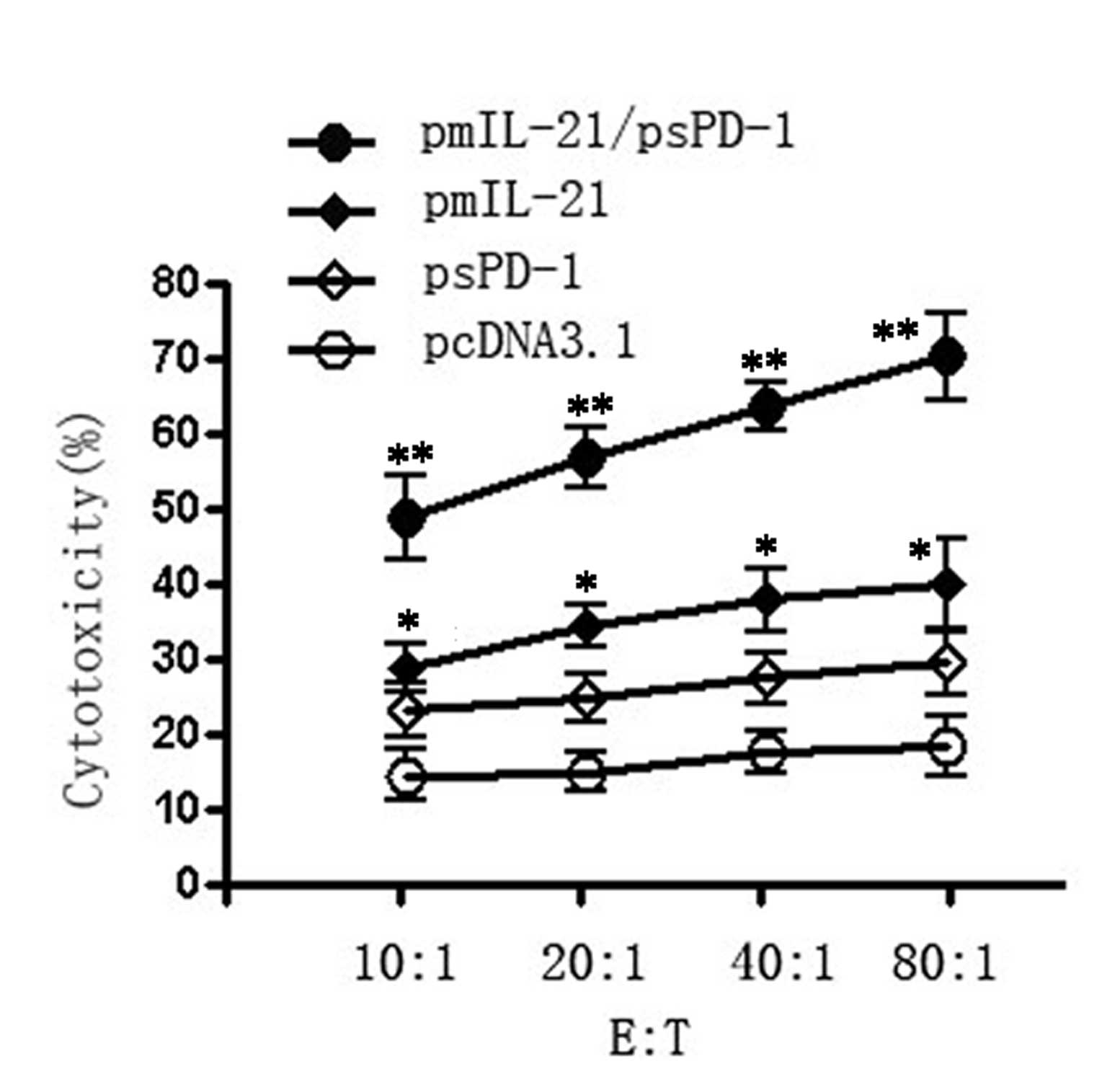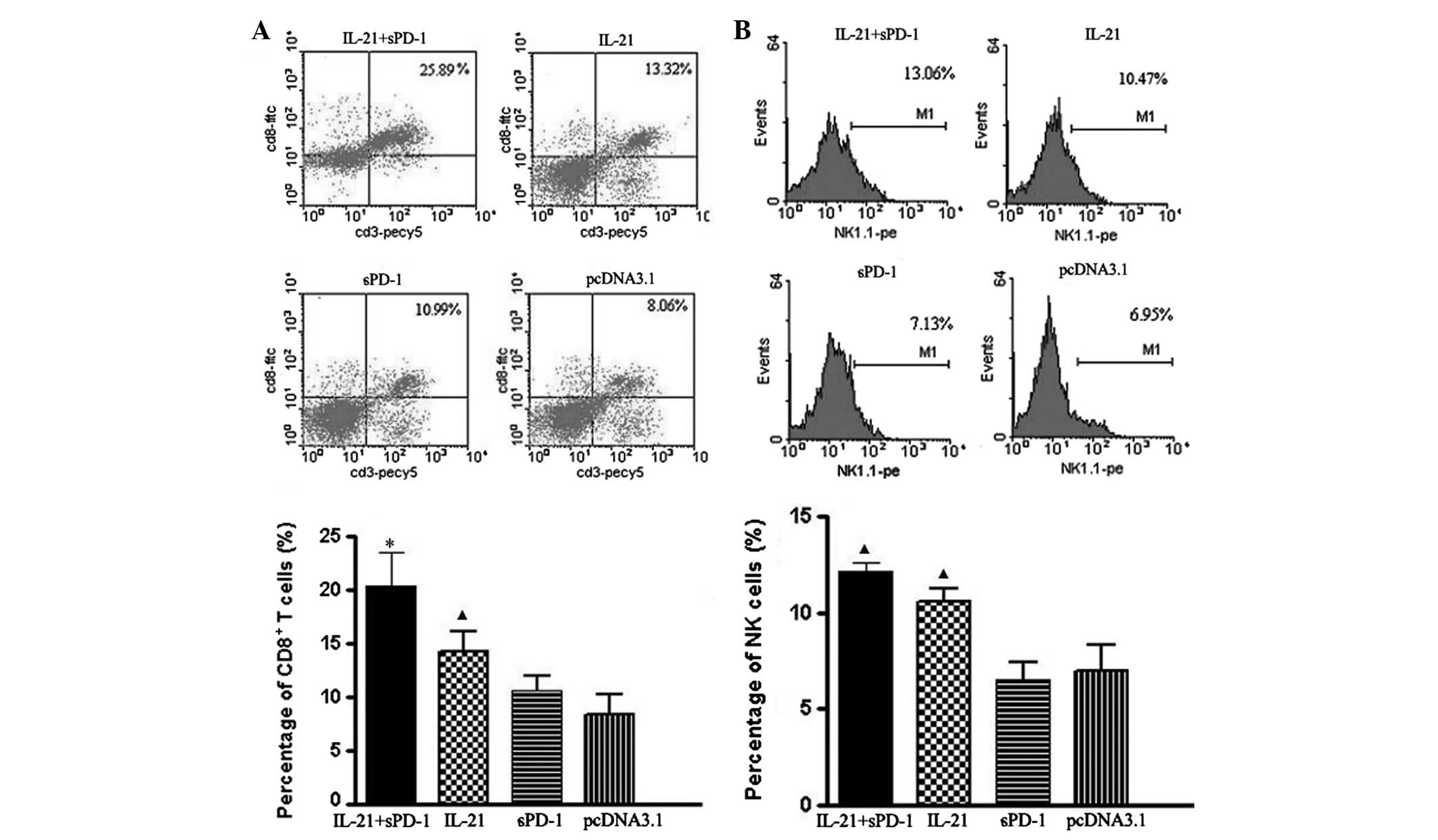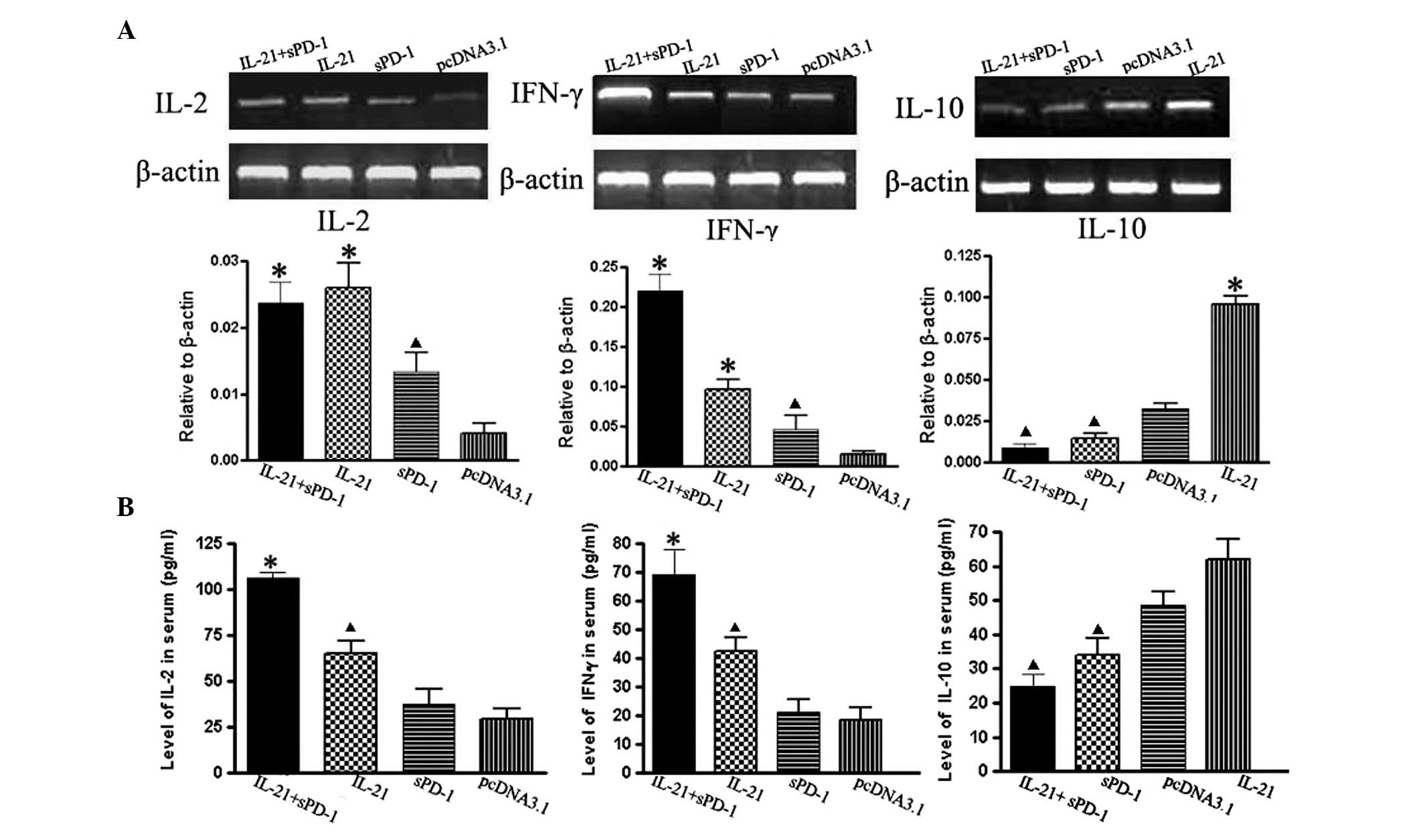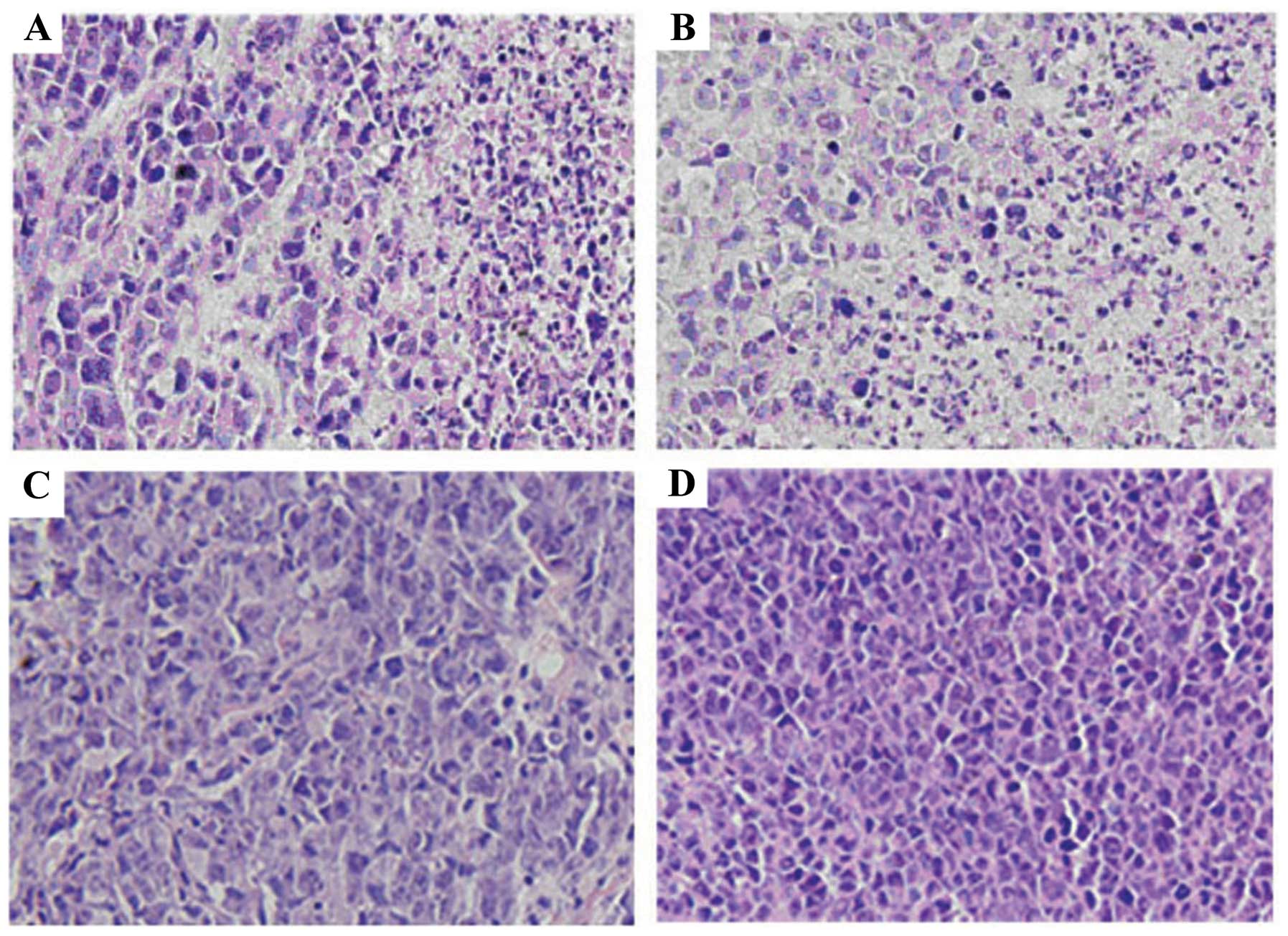Synergistic effects of soluble PD-1 and IL-21 on antitumor immunity against H22 murine hepatocellular carcinoma
- Authors:
- Published online on: October 12, 2012 https://doi.org/10.3892/ol.2012.966
- Pages: 90-96
Abstract
Introduction
Interleukin 21 (IL-21), a member of the common γ-chain (γc) receptor cytokine family, has been shown to have structural homology to IL-2 and IL-15. IL-21 is mainly secreted by activated CD4+ T cells and NK T cells (1–4). Its receptor (IL-21R) is widely expressed on various cell types within the immune system, including NK cells, B cells, T cells, macrophages and dendritic cells (DCs) (5–9). The widespread lymphoid distribution of the IL-21R leads to pleiotropic action of IL-21 in the innate and adaptive immune responses. A number of preclinical studies have shown that IL-21 has important anti-tumor effects (10–12). The antitumor activity of IL-21 has been shown to mainly depend on CD8+ T cells and NK cells. IL-21 promotes the activation and antigen-dependent proliferation of CD8+ T cells and enhances their cytolytic activity (13–15). It also regulates the proliferation, survival, differentiation and effector functions of NK cells (1,5,16). As a promising cytokine for cancer immunotherapy, IL-21 has been undergoing Phase I and II testing in clinical trials for the treatment of early phase renal cell carcinoma and melanoma (17–19).
Accumulated data have shown that tumors may exploit certain inhibitory checkpoints and pathways to escape immune attack, even in the face of a strongly induced antitumor immune response. In these tumor-escaping mechanisms, the expression of programmed death ligand 1 (PD-L1) by the tumor may play an important role in its resistance to immune destruction (20). PD-L1 is normally expressed in a broad spectrum of cell types and plays a crucial role in the maintenance of peripheral tolerance. Upregulated expression of PD-L1 has been found in certain solid tumors, including hepatocellular carcinoma. Its overexpression is significantly associated with tumor aggressiveness (21). The binding of PD-L1 to its receptor PD-1, expressed on activated T cells, was found to inhibit the proliferation of antigen-specific T cells, particularly cytotoxic T cells, to induce T-cell apoptosis, and to decrease the secretion of IL-2 and IFN-γ (20,22). Previous studies (23,24) have demonstrated that blockade of the PD-1 pathway may enhance antitumor immunity and inhibit tumor growth. Further studies have revealed that soluble PD-1 (sPD-1) blocks the PD-1 pathway and augments the antitumor immune response (25,26).
In this study, we used a gene transfer method to determine whether sPD-1 is able to enhance the effects of IL-21 in the treatment of hepatocellular carcinoma.
Materials and methods
Mice and cell lines
Female BALB/c mice (6–8 weeks old) were purchased from the Center of Medical Experimental Animals of Xuzhou Medical College (Xuzhou, China). The animals were maintained under pathogen-free conditions. The mouse protocol was approved by the Animal Care and Use Committee of Xuzhou Medical College. The mouse H22 hepatocarcinoma and 293T cell lines were purchased from the Institute of Oncology (Beijing, China). The mouse H22 cell line was maintained by intraperitoneal (i.p.) passage in BALB/c mice.
Plasmids
The murine sPD-1 expression plasmid vector psPD-1 has been described previously (27). Briefly, the cDNA of the PD-1 extracellular domain was obtained from the whole cDNA of murine splenocytes by reverse transcription-PCR (RT-PCR). The sequences of the PCR primers specific to sPD-1 are as follows: sense 5′-GGTTCATAGAATTCCTGA AGGCGACACTGCC-3′, (underlined nucleotides indicate EcoR I site) containing a restriction site for endonuclease EcoRI, and antisense 5′-CCTGGTAAGCTTATTGAAA CCGGCCTTCTGG-3′ (underlined nucleotides indicate HindIII. site) containing a restriction site for endonuclease HindIII. The plasmid vector psPD-1 was constructed by insertion of the purified sPD-1 cDNA into plasmid pcDNA3.1 and then sequenced by Shenggong Biotechnology Co. (Shanghai, China). Plasmid pcDNA3.1 was a gift from Professor Chenzhi (Institute of Infectious Disease, Zhejiang University, China). The murine IL-21 expression plasmid vector pmIL-21 was provided by Professor Doujun (Department of Microbiology and Immunology, Southeast University, China).
Cell transfection in vitro and in vivo
In the in vitro culture, the transfection of psPD-1 or pmIL-21 into 293T cells was performed using Lipofectamine 2000 liposomes (Invitrogen, Carlsbad, CA, USA) according to the manufacturer’s instructions. Stably transfected clones were selected using G418 (500 μg/ml).
In the in vivo animal studies, the transfection was performed by direct local injection. Briefly, BALB/c mice received an intramuscular (i.m.) injection of 100 μg naked plasmid in 100 μl saline at the inoculation site. The plasmids were injected every 3 days.
Tumor animal model and treatment protocol
The BALB/c mice (8 per group) received a subcutaneous injection of 1×105 H22 cells in the right hind limb to establish the hepatoma model. Day 1 post H22 cell inoculation, 100 μg plasmid DNA was injected directly into the muscle at the inoculation site in all treatment groups. In the combination treatment group, the mice received 50 μg pmIL-21 and 50 μg psPD-1 by i.m. injection. The plasmid or saline was injected every 3 days. The mice in the control groups received an equal amount of pcDNA3.1 or equal volume of saline. The mice were sacrificed on day 28 after injection of the H22 cells.
Tumor volume calculation and tumor growth inhibition (TGI)
The sizes of the implanted tumors were measured every week with a ruler. The tumor volume was calculated on days 7, 14, 21 and 28 using the formula: V=1/2(a×b2) (V, tumor volume; a, length, b, width). TGI was calculated using the formula: (1−T/C) × 100% (T, tumor volume of the treated group; C, tumor volume of the control group).
RT-PCR
Total RNA was obtained from the tumor marginal tissues of the tumor-bearing mice using the TRIzol reagent (Invitrogen) according to the manufacturer’s instructions. The relative quantities of the mRNAs of IL-2, IFN-γ and IL-10 were determined by RT-PCR using a Two Step RT-PCR kit (Tiangen Biotech Co., Ltd., Beijing, China); 30 PCR cycles were used for each sample and β-actin was used as the matched control. The primer sequences were as follows: IL-2 sense, 5′-ACCTTGCTAATCACTCC-3′, antisense, 5′-AAGTCCACC ACAGTTGCT-3′; IFN-γ sense, 5′-ATTGGCATAGATGTG GAA-3′, antisense, 5′-TCAAACTTGGCAATACTC-3′; IL-10 sense, 5′-ACCTGGTAGAAGTGATGC-3′, antisense, 5′-AAG GAGTTGTTTCCGTTA-3′; and β-actin sense, 5′-AGCGAG CATCCCCCAAAGTT-3′, antisense, 5′-GGGCACGAAGGC TCATCATT-3′.
ELISA
The IL-21- and sPD-1-expressing 293T clones (2.0×106/well) were cultured in 24-well plates for 24 h. The supernatants of the cultures were collected for IL-21 and sPD-1 detection. Murine IL-21 and sPD-1 ELISA kits (R&D Systems, Minneapolis, MN, USA) were used to identify the expression of IL-21 and sPD-1 proteins, respectively.
Mouse blood serum was collected on day 28 after injection of the H22 cells. We used murine IL-21, sPD-1, IFN-γ, IL-2 and IL-10 ELISA kits (R&D Systems) to assess the levels of IL-21, sPD-1, IFN-γ, IL-2 and IL-10 in murine serum.
Western blot analysis
Muscle tissues, isolated 72 h after the i.m. injection of psPD-1 or pmIL-21, were incubated with lysis buffer and a protease inhibitor cocktail (EMD Biosciences, Inc., San Diego, CA, USA) at 4°C for 20 min. Western blot analyses were performed using standard techniques. Protein levels were quantitated using a Bradford assay (Bio-Rad Laboratories, Hercules, CA, USA). Total protein (30 μg per lane) was run on 12% SDS-PAGE gel and transferred to a PVDF membrane. After blocking and washing, the membranes were incubated with antibodies against either IL-21 or sPD-1 in TBS-5% milk overnight at 4°C and then incubated with the appropriate secondary antibody. The proteins were detected using an enhanced chemiluminescence ECL kit (Santa Cruz Biotechnology, Inc., Santa Cruz, CA, USA). The expression of IL-21 or sPD-1 protein in the tumor tissues of the tumor-bearing mice treated with the sPD-1 and/or IL-21 gene were also detected as described above. Anti-mouse PD-1 polyclonal antibody was purchased from BioLend (USA) and anti-mouse IL-21 polyclonal antibody was purchased from ReliaTech GmbH (Wolfenbüttel, Germany).
CTL cytotoxicity assay
A lactate dehydrogenase (LDH) release assay was performed to determine the cytotoxicity of the mouse splenocytes. The splenocytes were co-cultured with irradiated H22 cells for 7 days in the presence of 20 U/ml rIL-2 and then used as effector cells for the cytotoxicity assay. The H22 target cells were plated at 5×103 cells/well in 96-well round-bottom plates and co-cultured with effector cells at various effector/target (E:T) ratios for 4 h at 37°C. After incubation, cytotoxic activity was detected by LDH release using the CytoTox 96 Nonradioactive Cytotoxicity assay (Promega, Madison, WI, USA) according to the manufacturer’s instructions. The rate of specific target cell lysis was calculated using the following formula: [(Sample release -spontaneous release)/(Total release-spontaneous release)] × 100.
Flow cytometry
Flow cytometry was used to detect the numbers of CD8+ T cells and NK cells in the spleen. A single-cell suspension of splenocytes was prepared from the spleens of the tumor-bearing mice. The cells were then stained with fluorescein isothiocyanate (FITC)-labeled anti-CD8, phycoerythrin (PE)-Cy5 anti-CD3 and PE-anti-NK1.1. These fluorochromes were detected using a flow cytometer (BD Biosciences, San Jose, CA, USA) and analyzed using CellQuest software. All antibodies used were purchased from BioLend (San Diego, CA, USA).
Histopathological analysis of tumors
The mice were sacrificed 28 days after injection of the H22 cells. The tumors were surgically excised and fixed in 10% formalin. The formalin-fixed tissues were embedded in paraffin and then sectioned for H&E staining. The slides were viewed with a microscope at a magnification of ×400.
Statistical analysis
For descriptive statistics, values are expressed as the mean ± standard deviation. The statistical significance of differences between groups was assessed using the Student’s t-test. P<0.05 were considered to indicate a statistically significant difference. Statistical analysis was performed using the GraphPad Prism 4.0 statistical software package (GraphPad Software, Inc., La Jolla, CA, USA).
Results
IL-21 and sPD-1 proteins were expressed in transfected cells and in vivo
Following the transfection of the recombinant plasmids into 293T cells and the establishment of stably IL-21- and sPD-1-expressing 293T cells, an ELISA was performed to detect the secretion of IL-21 and sPD-1 proteins by the transfected cells. We successfully detected high expression levels of IL-21 (839.98±56.38 pg/ml) and sPD-1 (764.64±61.25 pg/ml) proteins in the culture supernatants. We also examined the expression of IL-21 and sPD-1 proteins in the peripheral blood of the tumor-bearing mice. The levels of IL-21 protein were higher in the mice treated with the IL-21 gene alone (357.54±60.36 pg/ml) or in combination with sPD-1 (238±53.44 pg/ml) than those in the mice treated with the sPD-1 gene (98.37±27.64 pg/ml) or plasmid pcDNA3.1 (82.15±19.87 pg/ml), and the levels of sPD-1 protein were significantly elevated in the mice treated with the sPD-1 gene alone (369.53±97.37 pg/ml) or in combination with the IL-21 gene (217.38±65.64 pg/ml) than those in the mice treated treated with the IL-21 gene (57.86±21.30 pg/ml) or plasmid pcDNA3.1 (49.31±17.25 pg/ml). Later, we examined the expression of IL-21 and sPD-1 in vivo following the injection of naked recombinant plasmid DNA. As shown in Fig. 1, the IL-21 and sPD-1 proteins were detected in the injected muscle tissues or tumor tissues by western blot analysis.
Antitumor efficacy induced by IL-21 alone or in combination with sPD-1 in tumor-bearing mice
We measured the length and width of the implanted tumors and calculated the tumor volume on days 7, 14, 21 and 28 after the injection of the H22 hepatoma cells into the BALB/c mice. As shown in Fig. 2, treatment with the IL-21 gene alone significantly inhibited tumor growth at 14, 21 and 28 days after H22 cell injection, compared with tumor growth in mice receiving sPD-1 gene therapy or naked plasmid pcDNA3.1 (P<0.05). However, the combination of IL-21 and sPD-1 treatment showed the most potent suppression of tumor growth with a TGI of ≥70%. The sPD-1 treatment also resulted in a slight inhibition of tumor growth with a TGI of ≤20%. Therefore, the suppression of tumor growth by combined IL-21 and sPD-1 treatment was much stronger than that by IL-21 treatment alone (P<0.05). These data suggest that sPD-1 enhanced the IL-21-mediated antitumor responses.
Enhanced CTL cytotoxicity in pmIL-21- and psPD-1-injected mice
We next examined the CTL cytotoxic activities of splenocytes from the tumor-bearing mice injected with pmIL-21 alone or with a combination of pmIL-21 and psPD-1 on day 28 after tumor inoculation. Fig. 3 shows that the cytotoxic activities of the splenocytes to H22 tumor cells were significantly enhanced in the pmIL-21 group and in the psPD-1 group compared with the control vector pcDNA3 treatment group (P<0.01). However, the cytotoxicity of the splenocytes was further enhanced in the IL-21/sPD-1 combination group, compared with the IL-21 and sPD-1 gene single treatment groups (P<0.01). Thus, IL-21 and sPD-1 each mediate the cytotoxic function of splenocytes, and a combination of IL-21 and sPD-1 showed synergistic antitumor CTL cytotoxicity.
Increased CD8+ T cell and NK cell numbers in splenocytes following pmIL-21 and psPD-1 treatment
To further study the antitumor immunity trigged by pmIL-21 gene therapy, we counted the numbers of CD8+ T cells and NK cells in the splenocytes of the tumor-bearing mice. Fig. 4 demonstrates that the percentages of CD8+ T cells and NK cells were significantly increased in the pmIL-21/ psPD-1 combination group compared with the single-gene (IL-21 or sPD-1) treated groups (P<0.05). Treatment with IL-21 gene alone also resulted in significantly increased quantities of CD8+ T cells and NK cells compared with the control group (P<0.05). Moreover, the percentage of CD8+ T cells in the combined treatment group was higher than that in the IL-21 treatment group (P<0.05), which supports the synergistic efficacy of the sPD-1 and IL-21 treatments.
Effects of IL-21 and sPD-1 treatment on the induction of cytokine expression
Cytokines are important in immune responses. To assess the expression of cytokines associated with the antitumor immunity induced by IL-21 alone or in combination with sPD-1 treatment in tumor-bearing mice, we examined not only the serum levels of IL-2, IFN-γ and IL-10 by ELISA but also the transcription activities of IL-2, IFN-γ and IL-10 genes in tumor marginal tissues by RT-PCR. We found that in the combination treatment group the expression level of IFN-γ mRNA was markedly upregulated, but the expression level of IL-10 mRNA was significantly decreased compared with those in the single-gene treatment and control groups (P<0.05; Fig. 5). The changes of IL-2 and IFN-γ expression in the IL-21 treatment group showed similar trends to those in the control group. This was confirmed by ELISA detection of the cytokine levels in serum (Fig. 5). The sPD-1 blockade of PD-1 resulted in slight increases of IL-2 or IFN-γ expression levels but a significant decrease in IL-10 expression level relative to those in the control group (P<0.05).
Tumor histopathology analysis
To further investigate the antitumor effects of IL-21 and sPD1 treatment, tumor tissues were fixed and stained. Fig. 6A and B reveals that, consistent with the increased number of tumor-infiltrating immunocytes, increased numbers of necrotic or apoptotic tumor cells were found in the tumor sites derived from the tumor-bearing mice challenged with pmIL-21 alone or in combination with psPD-1. By contrast, tumor cells showed active growth and evident nucleic division in tumor sites derived from the tumor-bearing mice challenged with psPD-1 or pcDNA3.1 (Fig. 6C and D). These findings suggest that IL-21 alone or combination with sPD-1 is able to trigger the cellular immune response to the H22 hepatocellular carcinoma.
Discussion
Cancer immunotherapies usually focus on enhancing the ability of effector T cells to eradicate tumors. However, these therapies rarely translate into clinically satisfactory patient responses. It is now recognized that this failure is partially the result of the presence of negative regulatory pathways in the tumor microenvironment. These negative pathways dampen antitumor immune responses. The PD-L1:PD-1 immunosuppressive pathway is able to inhibit specific T-cell responses and may be associated with tumor cell immune tolerance (20). In this study, we investigated the antitumor therapeutic effects of transfection with recombinant plasmids containing sPD-1 and IL-21 against H22 hepatocellular carcinoma in mice. We found that IL-21 alone was able to induce a powerful antitumor immune response and that sPD-1 further increased the antitumor immunity mediated by IL-21. This treatment slowed tumor growth, reduced tumor size and resulted in increased tumor cell necrosis and tumor-infiltrating immunocytes, particularly in tumor tissues derived from the mice treated with IL-21 in combination with sPD-1. The current results suggest that the combination of IL-21 and blockade of PD-1:PD-L1 signaling with sPD-1 has a synergistic antitumor effect.
Other studies have shown that IL-21 elicits significant antitumor effects in mice with established tumors (28,29). However, to date, no study has demonstrated that IL-21 has antitumor activity in vivo in murine hepatocellular carcinoma models. In the present study, we first demonstrated that the administration of IL-21-gene expression vectors alone significantly inhibited the growth of H22 hepatocellular carcinoma tumors and induced an antitumor immune response. We found that CTL cytotoxicity and CD8+ T cell frequency in the spleen were significantly increased. In addition, the number of NK cells in splenocytes and the expression levels of IFN-γ and IL-2 in the serum or in the tumor margin were also enhanced. In addition to immunostimulatory effects, IL-21 has also been shown to directly increase the expression of PD-1 in T cells and of PD-1 ligands on APCs (30). The increased expression of PD-1 on T cells may decrease the antitumor effects of IL-21. In an attempt to address this issue, we investigated whether the antitumor effect of IL-21 could be synergistically enhanced by the blockade of the PD-L1:PD-1 pathway.
Previous studies have suggested that CD8+ T cells and NK cells are the main effector cells responsible for the lysis of tumor cells (31–33). The mechanisms underlying the CD8+ T-cell-mediated killing activity are direct contact-mediated cytotoxicity and the secretion of cytokines, including TNF-α and IFN-γ. NK cells not only destroy tumor cells directly, but they also modulate the development of adaptive immune responses. In this way, NK cells are critical to antitumor immunity. In this study, a combination of IL-21 and sPD-1 treatment led to significantly increased numbers of CD8+ T cells and NK cells and enhanced specific CTL cytotoxic activity in the splenocytes of the tumor-bearing mice as compared with single-gene (IL-21 or sPD-1) treatment. Although we did not determine whether immune stimulation by IL-21 in combination with sPD-1 results in similar changes in tumor-infiltrated lymphocytes, our findings suggest that the combined treatment may trigger innate and acquired immune responses, causing regression of the H22 hepatoma carcinoma in this mouse model
Cytokines have been shown to play a critical role in the modulation of innate and adaptive immune responses (34). In the present study, we found that the administration of IL-21 was able to upregulate the cytokines IFN-γ and IL-2, while sPD-1 treatment significantly reduced the expression of IL-10 in the tumor-bearing mice. The expression levels of IFN-γ and IL-2 were further enhanced in mice treated with a combination of IL-21 and sPD-1. In addition, the expression of IL-10, a negative regulatory cytokine, was also inhibited in the mice treated with the combination. These data suggest that increased levels of IL-2 and IFN-γ and reduced levels of IL-10 in the tumor-bearing mice treated with a combination of IL-21 and sPD-1 may all contribute to enhancements of the antitumor effects of CD8+ T cells or NK cells.
These findings demonstrate that immunotherapy with IL-21 in combination with sPD-1 is able to synergistically improve the efficacy of antitumor immune responses. For this reason, combination gene immunotherapy may be a valuable approach for the treatment of hepatocellular carcinoma.
Abbreviations:
|
sPD-1 |
soluble programmed death receptor-1; |
|
IL-21 |
interleukin 21; |
|
pmIL-21 |
plasmid carrying full-length cDNA of murine interleukin 21; |
|
psPD-1 |
plasmid carrying cDNA encoding the extracellular domain of murine PD-1 |
Acknowledgements
This study was supported by the Open Foundation of the Key Laboratory of Biological Cancer Therapy in Jiangsu Province (2008C02).
References
|
Parrish-Novak J, Dillon SR, Nelson A, et al: Interleukin 21 and its receptor are involved in NK cell expansion and regulation of lymphocyte function. Nature. 408:57–63. 2000. View Article : Google Scholar : PubMed/NCBI | |
|
Bryant VL, Ma CS, Avery DT, Li Y, Good KL, Corcoran LM, de Waal Malefyt R and Tangye SG: Cytokine-mediated regulation of human B cell differentiation into Ig-secreting cells: predominant role of IL-21 produced by CXCR5+T follicular helper cells. J Immunol. 179:8180–8190. 2007. View Article : Google Scholar : PubMed/NCBI | |
|
Kashiwakuma D, Suto A, Hiramatsu Y, Ikeda K, Takatori H, Suzuki K, Kaqami S, Hirose K, Watanabe N, Iwamoto I and Nakajima H: B and T lymphocyte attenuator suppresses IL-21 production from follicular Th cells and subsequent humoral immune responses. J Immunol. 185:2730–2736. 2010. View Article : Google Scholar : PubMed/NCBI | |
|
Coquet JM, Kyparissoudis K, Pellicci DG, Besra G, Berzins SP, Smyth MJ and Godfrey DI: IL-21 is produced by NKT cells and modulates NKT cell activation and cytokine production. J Immunol. 178:2827–2834. 2007. View Article : Google Scholar : PubMed/NCBI | |
|
Jin H, Carrio R, Yu A and Malek TR: Distinct activation signals determine whether IL-21 induces B cell costimulation, growth arrest, or Bim-dependent apoptosis. J Immunol. 173:657–665. 2004. View Article : Google Scholar : PubMed/NCBI | |
|
Brandt K, Bulfone-Paus S, Foster DC and Rückert R: Interleukin-21 inhibits dendritic cell activation and maturation. Blood. 102:4090–4098. 2003. View Article : Google Scholar : PubMed/NCBI | |
|
Distler JH, Jüngel A, Kowal-Bielecka O, et al: Expression of interleukin-21 receptor in epidermis from patients with systemic sclerosis. Arthritis Rheum. 52:856–864. 2005. View Article : Google Scholar : PubMed/NCBI | |
|
Caruso R, Fina D, Peluso I, Stolfi C, Fantini MC, Gioia V, Caprioli F, Del Vecchio Bianco G, Paoluzi OA, Macdonald TT, et al: A functional role for interleukin-21 in promoting the synthesis of the T-cell chemoattractant, MIP-3alpha, by gut epithelial cells. Gastroenterology. 132:166–175. 2007. View Article : Google Scholar : PubMed/NCBI | |
|
Pesce J, Kaviratne M, Ramalingam TR, Thompson RW, Urban JF Jr, Cheever AW, Young DA, Collins M, Grusby MJ and Wynn TA: The IL-21 receptor augments Th2 effector function and alternative macrophage activation. J Clin Invest. 116:2044–2055. 2006. View Article : Google Scholar : PubMed/NCBI | |
|
Di Carlo E, Comes EA, Orengo AM, Rosso O, Meazza R, Musiani P, Colombo MP and Ferrini S: IL-21 induces tumor rejection by specific CTL and IFN-γ-dependent CXC chemokines in syngeneic mice. J Immunol. 172:1540–1547. 2004.PubMed/NCBI | |
|
Dou J, Chen GB, Wang J, Zhao FS, Chen JS, Fang XS, Tang Q and Chu LL: Preliminary study on mouse interleukin-21 application in tumor gene therapy. Cell Mol Immunol. 1:461–466. 2004.PubMed/NCBI | |
|
Moroz A, Eppolito C, Li Q, Tao JM, Clegg CH and Shrikant PA: IL-21 enhances and sustains CD8+ T cell responses to achieve durable tumor immunity: comparative evaluation of IL-2, IL-15, and IL-21. J Immunol. 173:900–909. 2004.PubMed/NCBI | |
|
Liu S, Lizée G, Lou Y, Liu CW, Overwijk WW, Wang G and Hwu P: IL-21 synergizes with IL-7 to augment expansion and anti-tumor function of cytotoxic T cells. Int Immunol. 19:1213–1221. 2007. View Article : Google Scholar : PubMed/NCBI | |
|
Casey KA and Mescher MF: IL-21 promotes differentiation of naive CD8 T cells to a unique effector phenotype. J Immunol. 178:7640–7648. 2007. View Article : Google Scholar : PubMed/NCBI | |
|
Kim-Schulze S, Kim HS, Fan Q, Kim DW and Kaufman HL: Local IL-21 promotes the therapeutic activity of effector T cells by decreasing regulatory T cells within the tumor microenvironment. Mol Ther. 17:380–388. 2009. View Article : Google Scholar : PubMed/NCBI | |
|
Wang G, Tschoi M, Spolski R, Lou YY, Ozaki K, Feng C, Kim G, Leonard WJ and Hwu P: In vivo antitumor activity of interleukin 21 mediated by natural killer cells. Cancer Res. 63:9016–9022. 2003.PubMed/NCBI | |
|
Schmidt H, Brown J, Mouritzen U, Selby P, Fode K, Svane IM, Cook GP, Mollerup DH and Geertsen PF: Safety and clinical effect of subcutaneous human interleukin-21 in patients with metastatic melanoma or renal cell carcinoma: a phase I trial. Clin Cancer Res. 16:5312–5319. 2010. View Article : Google Scholar : PubMed/NCBI | |
|
Grünwald V, Desar IM, Haanen J, Fiedler W, Mouritzen U, Olsen MW and van Herpen CM: A phase I study of recombinant human interleukin-21 (rIL-21) in combination with sunitinib in patients with metastatic renal cell carcinoma (RCC). Acta Oncol. 50:121–126. 2011.PubMed/NCBI | |
|
Hashmi MH and Van Veldhuizen PJ: Interleukin-21: updated review of Phase I and II clinical trials in metastatic renal cell carcinoma, metastatic melanoma and relapsed/refractory indolent non-Hodgkin’s lymphoma. Expert Opin Biol Ther. 5:807–817. 2010.PubMed/NCBI | |
|
Dong H, Strome SE and Salomao DR: Tumor-associated B7-H1 promotes T-cell apoptosis: a potential mechanism of immune evasion. Nat Med. 8:793–800. 2002. View Article : Google Scholar : PubMed/NCBI | |
|
Gao Q, Wang XY, Qiu SJ, Yamato I, Sho M, Nakajima Y, Zhou J, Li BZ, Shi YH, Xiao YS, Xu Y and Fan J: Overexpression of PD-L1 significantly associates with tumor aggressiveness and postoperative recurrence in human hepatocellular carcinoma. Clin Cancer Res. 15:971–979. 2009. View Article : Google Scholar : PubMed/NCBI | |
|
Butte MJ, Keir ME, Phamduy TB, Sharpe AH and Freeman GJ: Programmed death-1 ligand 1 interacts specifically with the B7-1 costimulatory molecule to inhibit T cell responses. Immunity. 27:111–122. 2007. View Article : Google Scholar : PubMed/NCBI | |
|
Iwai Y, Terawaki S and Honjo T: PD-1 blockade inhibits hematogenous spread of poorly immunogenic tumor cells by enhanced recruitment of effector T cells. Int Immunol. 17:133–144. 2005. View Article : Google Scholar : PubMed/NCBI | |
|
Wang W, Lau R, Yu D, Zhu WW, Korman A and Weber J: PD-1 blockade reverses the suppression of melanoma antigen-specific CTL by CD4+ CD25 (Hi) regulatory T cells. Int Immunol. 21:1065–1077. 2009. View Article : Google Scholar : PubMed/NCBI | |
|
Onlamoon N, Rogers K, Mayne AE, Pattanapanyasat K, Mori K, Villinger F and Ansari AA: Soluble PD-1 rescues the proliferative response of simian immunodeficiency virus-specific CD4 and CD8 T cells during chronic infection. Immunology. 124:277–293. 2008. View Article : Google Scholar : PubMed/NCBI | |
|
Wang XH, Zhang GM, He YF, Zhang H and Feng ZH: Soluble PD-1 can augment anti-tumor immunity induced by HSP70-peptide complex in tumor bearing mice. Chin J Cell Mol Immunol. 20:655–658. 2004.(In Chinese). | |
|
He YF, Zhang GM, Wang XH, Zhang H, Yuan Y, Li D and Feng ZH: Eukaryotic expression and functional characterization of PD-1 extracellular domain. Chin J Biotechnol. 20:699–703. 2004.(In Chinese). | |
|
Dou J, Wang Y, Wang J, Zhao F, Li Y, Cao M, et al: Antitumor efficacy induced by human ovarian cancer cells secreting IL-21 alone or combination with GM-CSF cytokines in nude mice model. Immunobiolog. 214:483–492. 2009. View Article : Google Scholar : PubMed/NCBI | |
|
Jauch D, Martin M, Schiechl G, Kesselring R, Schlitt HJ, Geissler EK and Fichtner-Feigl S: Interleukin 21 controls tumour growth and tumour immunosurveillance in colitis-associated tumorigenesis in mice. Gut. 60:1678–1686. 2011. View Article : Google Scholar : PubMed/NCBI | |
|
Kinter AL, Godbout EJ, McNally JP, Sereti I, Roby GA, O’Shea MA and Fauci AS: The common γ-chain cytokines IL-2, IL-7, IL-15, and IL-21 induce the expression of programmed death-1 and its ligands. J Immunol. 181:6738–6746. 2008. | |
|
Arens R and Schoenberger SP: Plasticity in programming of effector and memory CD8 T-cell formation. Immunol Rev. 235:190–205. 2010.PubMed/NCBI | |
|
Cerwenka A and Lanier LL: Natural killer cells, viruses and cancer. Nat Rev Immunol. 1:41–49. 2001. View Article : Google Scholar : PubMed/NCBI | |
|
Smyth MJ, Hayakawa Y, Takeda K and Yagita H: New aspects of natural-killer-cell surveillance and therapy of cancer. Nat Rev Cancer. 2:850–861. 2002. View Article : Google Scholar : PubMed/NCBI | |
|
O’Garra A and Arai N: The molecular basis of T helper 1 and T helper 2 cell differentiation. Trends Cell Biol. 10:542–550. 2000.PubMed/NCBI |



